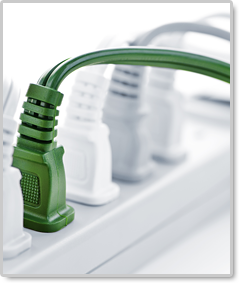Stop Paying for Electricity 'Vampires'

Turning off your computer when it is not in use is a great way to save energy. But did you know that even when the computer is switched off, it can still continue to suck electricity from your electrical outlet? This phenomenon of energy still being consumed when appliances or gadgets are turned off is called "vampire power," or sometimes "standby power" or "energy leaks."
Does My Home Have Electricity Vampires?
There are two simple ways to see whether your appliance is drawing vampire power:
-
If when you switch off the appliance or gadget there is a lit display on, then your gadget is drawing vampire power. This can typically happen with your television, computer monitor, DVR or phone charger.
-
Another simple way to find out if your appliance, charger or gadget is drawing vampire power is by placing your hand on it when it is switched off. If it feels warm to the touch, then it is drawing in energy and wasting it as heat . . . the vampire is striking!
Maybe you have already been hearing about this phenomenon, and are wondering if it is really such a big deal, or if it is all hype and urban myth? Well, the answer is that the impact of each appliance is relatively small, but when you add them all up . . . and remembering that they are all pulling power 24 x 7 . . . that the total cost of this vampire power can quickly add up.
It has been estimated that standby power use in the U.S. accounts for about 5% of total residential use. This amounts to about 4 billion dollars a year in wasted standby power!
Typical Vampire Power Costs
Shown below is a list of typical household appliances along with the annual cost you could be wasting by leaving them plugged in when they are not in use (the list was created by The Conscious Consumer along with the Lawrence Berkeley National Laboratory and the American Council of Energy-Efficient Economy, and it assumes electricity cost of 11 cents/kwh):
- Digital cable box with DVR $43.01
- DVR $36.63
- Set-top satellite box with DVR $27.52
- Digital cable box $17.65
- Satellite cable box $15.50
- Laptop computer $8.81
- Multifunction printer, scanner, copier $5.21
- CD player $4.99
- VCR $4.38
- Desktop computer $3.96
- Power tool $3.96
- Microwave oven $3.05
- LCD TV $2.97
- Plasma TV $2.97
- Handheld vacuum $2.97
- Answering machine $1.99
- Printer $1.98
- Computer speakers $1.98
- Answering machine $1.99
- Printer $1.98
- Computer speakers $1.98
- Cordless phone $1.98
- Electric toothbrush $1.98
- Portable stereo $1.64
- DVD $1.53
- LCD monitor $1.12
- Coffee maker $1.12
- AM/FM tuner $1.11
- CRT TV $1.00
- Video game console $1.00
- Cell phone charger (unattached to phone) $0.26
If you add up the items that are found in a typical home (one for each category) you will find that you may be very well paying nearly $100 per year in wasted standby electricity.
Avoiding Vampire Power Costs
But here are some tips you can follow to help you reduce this vampire power:
-
Unplug all battery chargers when they are not in use.
-
Unplug all appliances in the home which you use infrequently. Especially in the guest bedroom.
-
When you are leaving for a vacation, unplug as many gadgets or appliances you can.
-
When you buy new products, buy ones with low standby energy demand.
-
Use a power strip to switch off clusters of products.
-
Consider buying a standby power saver for your PC, TV, etc. For less than $20, you can control the vampire power of your PC peripherals or TV components.
Related Articles . . .
Slaying Your Worst Electricity Vampire
Did you know that it can cost you more for the electricity to keep your DVR box in standby mode, than it does for your subscription fee? This article and video discusses a device that helps cut standby costs.
Why NOT to Get a Home Energy Audit
Having a home energy audit done by a qualified professional can show you how to reduce your home’s energy bill by up to a whopping 30%. But what are the reasons that you should NOT get a home energy audit?
Kill-A-Watt Tips
A Kill-a-Watt electricity monitor is a great tool for helping you to identify ways to reduce electricity use around your home. Here are some tips on how to use this device.
Where Your Home Energy Dollar Goes
Ever wonder where your energy dollars go in your home? This article shows you at-a-glance, so that you can focus on the areas that will give you the biggest bang-for-the-buck for reducing your home energy bill.
How to Save $20 on Energy in April (or May)
This article and video describe very easy things that you can do, that will save you $20 on your energy bill during the months of April or May. And the nice thing is that these are all tips that you can do at little or no cost.
Programmable Thermostats Only Save If Used Right
Programmable thermostats can be a great way to save you money on energy, however, they can only provide savings when they are used properly. Find out how programmable thermostats work and the right way to use them.
14 Ways to Keep Cool AND Save Energy This Summer
Want to keep cool this summer and save money on your air conditioning bills? Here are 14 helpful tips. Some of these tips don't even cost any money!











